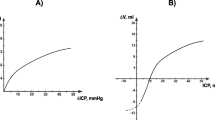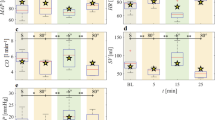Abstract
Vascular and tissue fluid dynamics in the microgravity of space environments is commonly simulated by head-down tilt (HDT). Previous reports have indicated that intracranial pressure and extracranial vascular pressures increase during acute HDT and may cause cerebral edema. Tissue water changes within the cranium are detectable by T 2 magnetic resonance imaging. We obtained T 2 images of sagittal slices from five subjects while they were supine and during −13° HDT using a 1.5-Tesla whole-body magnet. The analysis of difference images demonstrated that HDT leads to a 21% reduction of T 2 in the subarachnoid cerebrospinal fluid (CSF) compartment and a 11% reduction in the eyes, which implies a reduction of water content; no increase in T 2 was observed in other brain regions that have been associated with cerebral edema. These findings suggest that water leaves the CSF and ocular compartments by exudation as a result of increased transmural pressure causing water to leave the cranium via the spinal CSF compartment or the venous circulation.
Similar content being viewed by others
Author information
Authors and Affiliations
Additional information
Accepted: 6 November 1998
Rights and permissions
About this article
Cite this article
Caprihan, A., Sanders, J., Cheng, H. et al. Effect of head-down tilt on brain water distribution. Eur J Appl Physiol 79, 367–373 (1999). https://doi.org/10.1007/s004210050522
Issue Date:
DOI: https://doi.org/10.1007/s004210050522




